Joined at the Toe Clip
By Roy M. Wallack, Special to The Times
November 30, 2004
Eight years ago four cyclists who were complete strangers put themselves through a 508-mile introduction in the Southern California outback. Their cramp crucible united them in a brotherhood of pain.
"Ugghhhhh—my leggg!" After six hours of battling 40 to 50 mph headwinds, cresting the bleak Amorgasa Mountains out of Death Valley, my right hamstring seized-up as if hit by a gunshot. As I'd reached over for a water bottle, it suddenly balled up in a stabbing, paralyzing knot that felt like it was ripping off my bone. Frantically, I braked and toppled off the bike.
"Sorry guys, sorry guys, sorry …" I babbled, squirming on the ground.
Ron, Steve, and Keith rushed out of the support van and stood around me, speechless. What could they say? They'd come all this way, worked so hard, spent so much time and money. And now, at 3 a.m., 18 hours into the Furnace Creek 508, when they're counting on me to keep the momentum going, I'm letting them down. Again.
Eight years earlier in a dramatic, down-to-the wire battle, this same team had lost the Furnace Creek team race by four minutes. Nobody blamed me, but my snail's pace, especially on the climbs, stood out on a team with accomplished racers. My passion was bike touring, not racing. I'd given my all, but my all was too slow. In the years since, I trained like a madman in the hills to erase my shame—only to wind up in a pathetic, cramp-induced sprawl on Highway 178.
The Furnace Creek 508 is one of the world's toughest cycling events. The 508-mile A-shaped route over high desert and mountains spans 35,000 feet of total climbing, 100-degree heat in the day, freezing cold at night and 40 mph winds in spots. From Santa Clarita, north of Los Angeles, riders strain northeast across the Mojave Desert and the Tehachapi and Panamint Mountains to Death Valley and then southwest over the Amargosas to Twentynine Palms, an hour north of Palm Springs. Since 1989, hundreds of endurance riders from around the globe (Slovenia, Italy and Finland this year) have come to take on the course, formidable enough to be a qualifier for the 3,000-mile Race Across America (RAAM).
The 508 has became a goal unto itself for solo riders like 2002 winner Eric Ostendorff of Torrance, 43, and Peter Pop of Malibu, 55, a two-time 90s RAAM rider attempting a record seventh 508 finish in October's race.
But it's the team category— contributing over half of this year's record 122 riders—that jacks up the gauntlet, adding the pressure of pulling your weight when you're road kill.
Ron, Steve, Keith and I were four strangers when the '96 race began and something quite different when we finished 24 hours, 53 minutes and 1 second later. We had met the night before—an arranged marriage, orchestrated by the race director—and didn't talk much during the ride itself. But the intensity of the experience—in Keith's words, like "a drug-induced nightmare, without the drugs"—bound us like soldiers in a foxhole, a connection you don't get in, say, miniature golf.
Pushing to the edge of anaerobic sanity for 30 minute "pulls" and collapsing into a chest-heaving heap on a mattress in the van until my next turn, I remember little of the '96 race or my teammates except for one thing: the gasping—the frantic in-and-out of desiccated desert air blasting my throat, distending my diaphragm, searing my cilia. It left me with a raw throat for weeks and a sputtering, muffled cough for months.
But as memories of the pain faded, a euphoric imprint remained: The feeling of being part of a team. And it brought us together a second time last month. Ron Jones flew in from Atlanta. Steve Ilg delayed a trip to an ashram in India. Keith Kostman (brother of race director Chris Kostman) flew in from Minneapolis, and I fought traffic from Irvine. Team Sasquatch was back—despite all reason. This time I hoped to prove, especially to Ron, that I belonged in the same rented panel van as the rest.
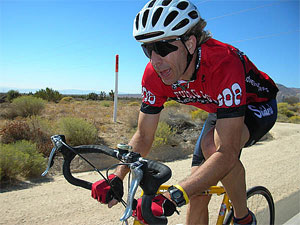 Three divorces. Three marriages. Two cross-country relocations. Two new careers. Except for me, everyone's lives were rocked by seismic shifts as we entered a new competitive age bracket, moving from 30-plus to firmly 40-plus. But on the bike, one thing remained a constant: Ron's speed.
Three divorces. Three marriages. Two cross-country relocations. Two new careers. Except for me, everyone's lives were rocked by seismic shifts as we entered a new competitive age bracket, moving from 30-plus to firmly 40-plus. But on the bike, one thing remained a constant: Ron's speed.
At the chilly 9 a.m. start in Santa Clarita, he bolted to the front of the team race. The 44-year-old corporate wellness coach from Lawrenceville, Georgia flung himself past the wind-bent Juniper trees on the long 2,500-foot climb out of town and into the flat, Joshua Tree-studded Mojave Desert with the same abandon he had in 1996.
At the time of our first 508, we only knew Ron as a somewhat-famous, small-town bike racer. We didn't know that at age 28 he had been an angry, hard-drinking contractor who first started riding after making a 1988 New Year's resolution to get fit and be a better example to his young daughter. Jones entered his first race at 30, collected a garage full of trophies, but burned out. "I was training viciously, angrily, venting on the bike," he says. He started college, lettered on the track team at age 35 and was recruited for the relay division of the Race Across America. When a documentary about the team's win made him a local hero in his hometown of Bakersfield and in-demand as a speaker, Jones realized he'd found his niche as a fitness and team training expert.
"Team events are a higher level of understanding than solo events," says Ron. "It's just not about being a bad-ass who can win races. It's almost spiritual, the sense of helping make the whole greater than the sum of its parts."
By noon, riding strong tailwinds, Ron had blown through tough, windmill-covered hills and a vast airplane-repair graveyard miles on his way into California City, the first checkpoint. He would finish his 82-mile segment in 3 hours, 25 minutes—24 mph, impressive given the 5,000 feet of climbing. He was miles ahead of everyone else.
"He's sending a chi statement," said Steve, owner of a Tarzana yoga studio. "There is no duality in his dharma. This is karma in action. "
I had no idea what that meant. But with each of us rotating twice for up to 6 hours a shot this time and covering distances of 38 to 99 miles (due to a change in format from the last race), I'd have plenty of time to find out. The three non-riders now had hours to gab about our lives, plot strategy, monitor our rider's form, and anticipate his hydration and nutrition needs. Last time we were like independent contractors. Now, as Ron reminded us when he got into the van, we literally had to watch each other's backs.
"We've got to make those Gatorade handoffs smoother, guys," he said. "We've got to get the rider a new bottle before he runs out. We can't drive too far ahead—in case the rider gets a flat. And we have to watch the hell out of Keith, because he still doesn't know how to shift gears."
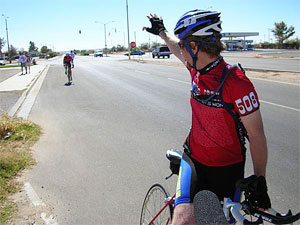 THE GOOD WIND
THE GOOD WIND
As Keith, 41, set off on his 70-mile segment, he was even more afraid of not measuring up than I was. That's because he wasn't a cyclist. In 1996, as a full-time Spinning instructor who had never ridden a road bike, he could pedal balls-out for 30 minutes but would infuriate Ron by often being in a hill-climbing "granny gear" while descending. Now divorced, relocated, and remarried to a Minneapolis bartender, Keith had given up indoor cycling for "my true calling:" teaching elementary school. Animated, enthusiastic and iconoclastic, he doesn't buy the reflexive pat on the back, often telling his kids, "No matter how good you do, you can always do better." Determined to make Team Sasquatch, and Ron, proud, despite his lack of Spinning fitness, he trained 36 days in a row on mountain bike trails around Twin City lakes. It paid off. Helped by 40 mph tailwinds, Keith was stunned to find he'd ridden 25 miles in the first hour.
After rejoicing inside the van, Ron, Steve, and I went back to getting to know each other. I discovered that they had become such close friends after the first 508 that Ilg served as the best man at Jones' wedding. We got the lowdown on kids and ex-wives, swapped fitness tips, argued politics, discussed the meaning of yoga terms, batted around some book ideas. Then we realized we'd forgotten about Keith.
Three miles back, in 90-degree heat, we found him pedaling an agonizingly slow cadence uphill in a downhill-worthy gear. He'd run out of Gatorade 30 minutes earlier. His perpetually sunny disposition had more than a few dark clouds in it. Team Sasquatch was passed by several teams.
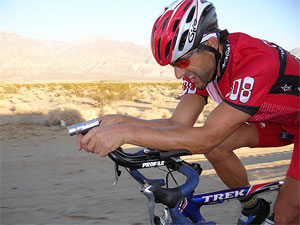 Rehydrated, Keith blew into the ghost-town desolation of Trona, flying past a factory belching giant white piles of diatomacious earth and ponds of putrid water boiling in the sun, surely emanating toxic gas. Whipped by crackling tailwinds over blissful miles of descent and straightaway, he finished the last 20 miles in 40 minutes—that's 30 mph!—and handed off to Steve Ilg.
Rehydrated, Keith blew into the ghost-town desolation of Trona, flying past a factory belching giant white piles of diatomacious earth and ponds of putrid water boiling in the sun, surely emanating toxic gas. Whipped by crackling tailwinds over blissful miles of descent and straightaway, he finished the last 20 miles in 40 minutes—that's 30 mph!—and handed off to Steve Ilg.
Twelve years ago, Outside magazine ran picture of Steve on the cover, with the words, "This man can break you down—and build you up again." Since then, little has changed physically. At 44, he is muscular as a gymnast, limber as a yogi, as aerobically fit as a marathoner. Steve, has competed at high levels in cycling, cross-country skiing, rock climbing, and paddling. A registered yoga instructor and cycling coach, he's authored several books, including the recent "Total Body Transformation," which combines yoga and weight training. Married and crushed in a divorce since we last rode together, he was more philosophical than before.
"We have already traveled the physical terrain together," he said before the race. "Now we will explore the spiritual side of the journey.
"The team concept is vital to spirituality because you can't be self-serving. You need to give your teammates nutrition, inspiration, harmony. Your teammates are your prayers; you have to take care of them."
Our prayers were answered quickly. Shifting into his so-called "inner gear," Steve attacked his 99-mile segment, longest of the 508, like a starving yogi inhaling a veggie burger. In two hours he blitzed the 50-mile length of the Panamint Valley. Suddenly, it was dusk, and a long string of red tail-lights rose before us like Christmas lights. It was what others dread and this powerful, compact athlete is made for: the 13-mile, climb up to 4,956-foot Townes Pass. Steve began passing riders so fast we didn't have time to identify them. But even he had limits. On the last third of Townes, with fatigue clearly setting in, we pulled next to him. "Bro—you have to hammer past those last three remaining lights up ahead," shouted Ron. "The summit's coming soon, and to keep you safety in our headlight 'bubble', we don't want any traffic on the way down."
Experts say that motivation can come from two sources: internal or external, ego-oriented or task-oriented. Top athletes have both.
After amping up his ego and task engines, Ilg sighed, dug down and took off. By the time he topped the summit, he had gotten the gap Ron wanted for the freezing, frightening, 5,000-foot, 17-mile descent into Death Valley.
THE EVIL WIND
I had an inkling that my 74-mile pull was going to be slow before it started. Steve was having trouble controlling the bike on the descent of the pass. And down in Death Valley, he suddenly was straining to go 12 mph.
The route had turned south—right into the 40 mph tailwind. Now it was a howling headwind gusting to 50 mph. Furnace Creek veterans would say later that it was the worst wind in the history of the race.
Riding against a headwind is normally the most depressing thing you can do on a bike; unlike a hill, there's no reward at the top. But even though some gusts slowed me to a walk and I had to lean at an angle to keep from being blown over by sidewinds when the road curved, I found the battle strangely liberating.
I have a high tolerance for discomfort, and figured, if this was bad for me, it was worse for everyone else. And it was.
Peter Pop, unable to control his steering, eat or drink well (out of fear of taking hands off the handlebars), or see 5 feet ahead at times due to sand storms, dismounted and walked a mile to Badwater—the only time he'd walked in his long cycling career. At 5-feet, 105 pounds, Debbie Caplan, 39, of Agoura Hills was blown around "like a piece of lint." "I pulled over at Badwater at 1 a.m., crying," she said. "I'd trained all year and was in the best shape of my life."
The next day, she was the last person to drop out.
In winds like this, bulk helps. At 5-foot-9, 185, I had it, and passed at least a half-dozen riders. Each one provided me with peace of mind: My teammates, especially Ron, now had concrete evidence that I wasn't as slow as I used to be.
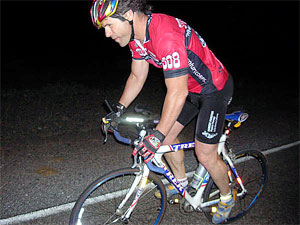 "Self-ego preservation is a huge issue on teams that don't know each other well," says Kristen Dieffenbach, Ph.D., a USA Cycling sports psychologist and professor at Maryland's Frostburg State University with a specialty in team dynamics. "Your situation with your team was unique. If you know your teammates, you have social acceptance—"they like me anyway," you think—so you can afford to slack off."
"Self-ego preservation is a huge issue on teams that don't know each other well," says Kristen Dieffenbach, Ph.D., a USA Cycling sports psychologist and professor at Maryland's Frostburg State University with a specialty in team dynamics. "Your situation with your team was unique. If you know your teammates, you have social acceptance—"they like me anyway," you think—so you can afford to slack off."
I couldn't if I wanted to make Jones proud. I constantly moved my hand position, body position, and the firing sequence of my thigh and butt muscles. Eventually, I settled on a standing position that may have looked inefficient but allowed good control in the unpredictable gusts and conserved energy by pushing the pedals with body weight rather than pure muscular effort. Meanwhile, I was mining my memory for pain that was worse than this—the 1999 Boston marathon, the 750-mile Paris-Brest-Paris in '91—when a rider appeared out of the darkness and passed me as if I was standing still.
I tried to keep up—for about five seconds. I upshifted and rocked hard for leverage. My quads, happy in their groove, immediately protested. Calm down—or blow up, they warned. The guy disappeared like a ghost.
"Who was that?" I screamed. I thought we were way ahead of all the four-man teams by now. And we were.
"That was Velociraptor," yelled the guy. Velociraptor Mindset Multisport of Walnut Creek, California—the only coed team. Two girls and their boyfriends. The double-date from hell.
Being 30+ and coed, they weren't in our division—and were out of my league. Even Jones could see that. Couldn't he?
There was no time for distraction. Coming up: the 15-mile, 4,000-foot climb out of Death Valley and the dreaded back-to-back ascents of Jubilee and Salsberry Passes. I caught a few exhausted solo riders, but by 2:30 a.m. the climbing was getting to me. I needed a boost, but had run out of tricks. As if on cue, the Sasquatch van pulled up. "We need you to go faster," said Kostman, calmly. "See that red light up there? Go get it."
Instantly, remarkably, I was energized. The red dot went down. Kostman pulled up again. "Get going, you slacker! Get those two." More red dots fell.
"Seventy-three miles is a long time to stay concentrated," said Dieffenbach. "Keith tapped into your need to prove your worthiness to the group and gave you tiny stepping stones, specific goals and tasks to break the race down into smaller segments."
A couple miles from the top, Kostman held a Gatorade for me out the window. When I reached for it, my leg exploded.
Initially, all I could think was that the race was over. I'm wrecked—and I've wrecked it for these guys. But as I lay on the ground with my teammates all around me, their silent worry screaming through the sky, I grew calm.
Support from others can have a remarkable effect on our response to pain. It can change neurochemistry, says psychologist Arthur Ciaramicoli, author of "Performance Addiction" and an instructor at Harvard Medical School. "We produce more serotonin when we have an empathic exchange. It actually reduces pain that you're feeling at the time. It makes you perform through the pain. You want to do it for the other people. You want to achieve something larger than yourself."
"I'll be okay," I said. Surrounded by Ron, Steve and Keith, I stretched my quad and hamstrings for 60 seconds and got back on the bike. Remembering Steve's heroic push to the top of Townes Pass, I plowed ahead and wound up catching the last few dots by the summit.
"I got a major chi hit from that!" Steve told me at the checkpoint.
That's a huge compliment.
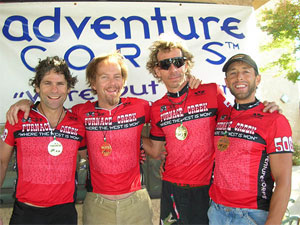 VALIDATION
VALIDATION
The wind never slackened for the rest of the race. Nearly half of the solo riders quit, the worst drop-out rate ever. Veteran Pop finished, but vowed to never do a solo again. 2002 winner Eric Ostendorf dropped out, as did former RAAM winner Seana Hogan. As for Sasquatch, we lengthened our lead over the 4-man division and even passed Velociraptor at 6:57 a.m. Jones, in a show that left us dazzled, stood in the saddle for an hour straight against the headwind and made up 42 minutes on them in the next 56-mile segment.
But lacking a couple more Rons, we were caught by the Super Couples during Kostman's pull and eventually finished an hour back. Still, our time of 31:45:32 was two hours faster than the next-best men's team.
Asked for our most memorable moments by the video crew after I crossed the finish line, Keith, Steve, and I mentioned Jones catching Sasquatch on his second pull. As for Jones, his best two memories were of me—first, for blurting the words "sorry, guys" when my hamstring blew, and next, for standing up on the bike nearly six hours straight. Most people can't ride standing for ten minutes.
"I thought, 'Wow, if Roy can do that, I can surely stand for an hour,' " he said. "That's why I caught Velociraptor."
A rush of pride enveloped me, maybe the best feeling I've ever had in a lifetime of athletics. Ron Jones, inspired by me?